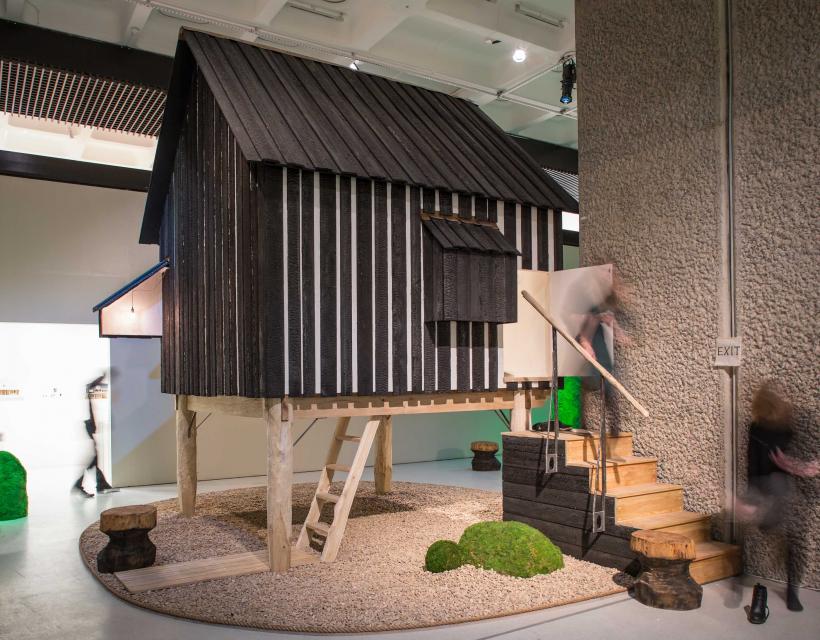It might come as a surprise but the average life span of a building in Tokyo is thirty years. Decimated by natural disasters and catastrophic bombing during the Second World War, Japanese houses tell a story of resilient architecture that chases the modern while evoking the traditional. Endlessly erased, adapted and mutated, it is a palimpsest of the old and the new, the fleeting and the enduring, ephemerality and physicality. While post-war Japanese architecture might have struggled to find its identity, it has often amused with its inventiveness and sophistication. Somewhere between the functionalism and impermanence is what we might call the essence of Japanese living.
‘The Japanese House: Architecture and Life After 1945’ at the Barbican is an exhibition that, alongside showing ground breaking architectural designs and their socio-economical contexts, attempts to dig deeper into the psyche of the Japanese family. Spread across two floors centred around a courtyard with lovingly reconstructed walk-through models of contemporary Japanese rooms, the show allows us to sense what it’s like to live in these finest examples of nanotecture. The gallery’s split level layout creates a peek-a-boo viewing experience, also attributed to the use of spatial margins (such as staircases, floor landings etc.) that create a feeling of openness and homeliness simultaneously. The soundtracks from Japanese home dramas and cartoons screened in various rooms permeate the air, recalling neighbours living next door and creating a space where the public and the private spheres blend organically.
This staple Japanese concept of openness, incorporating the outside environment into the family dwelling is introduced in the example of Katsura Imperial Villa in Kyoto (ca. 1615-56), exquisitely photographed by Yasuhiro Ishimoto in the 1950s. Built with traditional materials such as wood and bamboo, every arrangement of the smallest detail was designed to be followed by the body’s natural movement. At the core of the house is a veranda; an in-between zone and a symbol of the loose boundary between the privacy of the home and the external landscape. Profoundly traditional as it may seem, the Katsura Villa was also uniquely modern and inspired such brutalists as Le Corbusier and Walter Gropius who praised its Mondrianesque design. Suddenly, viewing the show whilst being surrounded by the Barbican estate gains more significance. It feels right to be here.
Room by room, the exhibition draws a history of Japanese architecture, responding to the post-war austerity with concrete utilitarianism, and to the economic affluence of the 1970s with technologically advanced experimental housing. Complemented by films, documentaries and photographs, this show gradually becomes more of a survey of Japanese family life, often hiding its darker underbelly. The overarching impression of being steeped in architectural bliss soon disappears, especially when viewing some artistic responses to society’s consumerism and alienation. Mako Idemitsu’s short film ‘Another Day of a Housewife’ (1977-78), is a record of a mundane existence surveyed by the ever-present TV monitor. The exhibition also includes Katsuhira Miyamoto’s ‘Zenkai House’ (1997) which illustrates the catastrophic consequences of earthquakes and unforgiving governmental policies that favour erecting endless new structures above preserving the old ones. Another problematic aspect of Japanese housing is considered in the black and white photographs of Ryuji Miyamoto, who documented homelessness in the post bubble 1990s through images of tiny cardboard homes, some of which fit between perfectly trimmed shrubs and bushes.
Perhaps these uncomfortable aspects of Japanese housing problems are not exploited enough in the show. Not all these homes are airy and holistic, with most of Japanese society still living in claustrophobic flats. Some are crammed with the most peculiar collections, as depicted by Kyoichi Tsuzuki in ‘Tokyo: A Certain Style’. Nevertheless, this survey is a delight for the eye, a feast for the senses and food for thought too. It shows the joy of architecture, even though this joy might be a false utopia.


__large.jpg)
__large.jpg)
__large.jpg)
__large.jpg)
__large.jpg)
__large.jpg)
__large.jpg)
__large.jpg)

__large.jpg)

__large.jpg)
__large.jpg)
